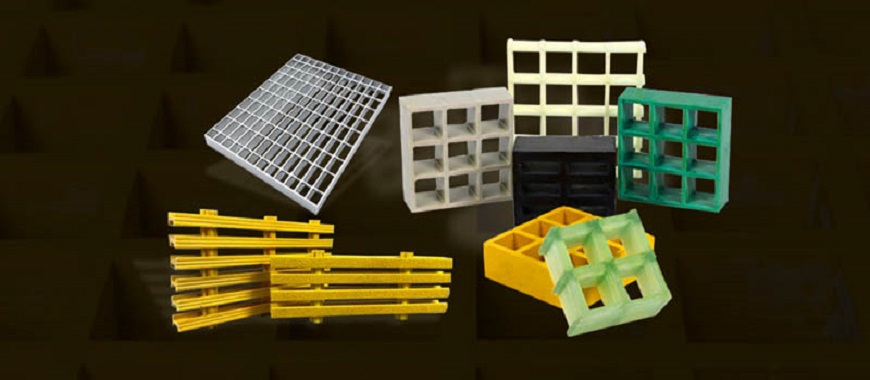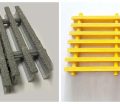
Grating hinges are essential components used in various applications where grating systems are employed. These specialized hinges are designed to provide reliable and efficient access to areas covered by grating, allowing for easy opening and closing without compromising the structural integrity of the grating. The importance of grating hinges cannot be overstated, as they ensure safety and accessibility in environments such as industrial facilities, warehouses, and construction sites. Their durability and strength make grating hinges capable of supporting heavy loads while withstanding harsh conditions, which is crucial in demanding industrial settings. By integrating robust grating hinges into grating systems, users can achieve both functionality and reliability, facilitating maintenance and operations in areas where safety and access are priorities.
What Are Grating Hinges?
Grating hinges are specialized hardware components designed to facilitate the opening and closing of grating systems, such as access covers and removable panels. These hinges play a crucial role in ensuring that grating remains securely attached while allowing for easy access to the areas beneath the grating, such as drainage systems, electrical conduits, or maintenance spaces. The primary purpose of grating hinges is to provide a reliable pivot point, enabling smooth movement without compromising the structural integrity of the grating.
Materials Commonly Used for Grating Hinges
Grating hinges are typically made from robust materials that can withstand the demands of industrial environments. Two of the most common materials used in the manufacture of grating hinges are:
- Steel: Steel grating hinges are favored for their exceptional strength and durability. They can support heavy loads and resist wear and tear in high-traffic areas. Galvanized or stainless steel finishes are often used to enhance corrosion resistance, making them suitable for outdoor or wet environments.
- Fiberglass: Fiberglass grating hinges are a lightweight alternative that offers excellent resistance to corrosion and chemicals. They are particularly useful in environments where metal hinges might be prone to rust or degradation. Fiberglass hinged grating also provide a non-conductive option, which can be beneficial in electrical applications.
Grating hinges are essential components in grating systems, providing accessibility and structural integrity. The choice of material, whether steel or fiberglass, impacts their performance and suitability for various applications, ensuring that the grating system functions effectively in its intended environment.
Types of Grating Hinges
Grating hinges come in various types, each designed for specific applications and environments. Understanding the different types of grating hinges can help in selecting the right one for your project, ensuring that they meet the necessary requirements for strength, durability, and functionality.
Steel Grating Hinges
Steel grating hinges are widely used due to their exceptional durability and strength. These hinges are capable of supporting significant weight and are resistant to wear and tear, making them suitable for high-traffic areas in industrial settings. The robust nature of steel allows these hinges to withstand harsh environmental conditions, including exposure to chemicals and moisture, especially when finished with galvanization or stainless steel coatings. The primary advantage of using steel grating hinges is their long service life, which reduces the need for frequent replacements and maintenance.
Heavy Duty Grating Hinges
Heavy-duty grating hinges are specifically designed for applications that require higher load capacities and increased robustness. These hinges are often made from thicker materials and feature reinforced designs to handle the stresses associated with heavy use. They are ideal for environments such as manufacturing plants, warehouses, and loading docks, where heavy equipment and machinery operate. The use of heavy-duty grating hinges ensures that access points can withstand substantial forces without compromising safety or functionality.
Weld-on Hinges
Weld-on hinges offer a permanent solution for grating systems in heavy-duty applications. These hinges are attached directly to the grating or frame through welding, creating a secure and stable connection that enhances the overall integrity of the assembly. The primary benefit of weld-on hinges is their ability to support significant loads without the risk of loosening or detaching over time. They are commonly used in industrial settings where a permanent fixture is necessary for safety and operational efficiency.
Weld-on Hinges for Gates
Weld-on hinges for gates are a specialized type of grating hinge that is designed specifically for securing and supporting gate structures. These hinges are engineered to provide enhanced security and stability, making them ideal for use in perimeter fencing, access control points, and heavy gates. The welded connection ensures that the gate can withstand dynamic loads, such as wind pressure or frequent use, while maintaining alignment and functionality. Additionally, these hinges can be tailored to accommodate various gate sizes and weights, ensuring a reliable operation in demanding environments.
The types of grating hinges, including steel grating hinges, heavy-duty grating hinges, weld-on hinges, and weld-on hinges for gates, each offer unique benefits tailored to specific applications. Understanding these variations allows for the selection of the appropriate grating hinges to meet project requirements, ensuring durability and functionality in various industrial and commercial settings.
11 W 4 Grating: Understanding the Importance
Applications of Grating Hinges
Grating hinges are versatile components that find extensive applications in various industrial settings, particularly in entrance grating systems, due to their robust design and reliable performance. They are crucial in facilitating access and maintaining structural integrity in grating systems, ensuring that entrance grating remains secure while providing easy entry for maintenance and cleaning.
Common Uses in Industrial Settings
- Connecting Grating Panels in Walkways, Platforms, and Ramps: Grating hinges are commonly used to connect grating panels in walkways, platforms, and ramps. Their ability to pivot allows for easy access to areas below the grating while maintaining a secure and stable walking surface. This application is particularly important in environments where safe pedestrian movement is critical, such as factories and warehouses. The use of grating hinges in these settings ensures that walkways and platforms remain functional and compliant with safety regulations.
- Supporting Access Points in Manufacturing Facilities: In manufacturing facilities, grating hinges are essential for supporting access points to equipment and maintenance areas. They provide a convenient way to open and close grating covers, allowing maintenance personnel to quickly reach machinery and perform necessary inspections or repairs. The durability of grating hinges ensures that they can withstand the demands of heavy use in busy manufacturing environments, contributing to overall operational efficiency.
- Gate Installations in Secure Areas: Grating hinges are also widely utilized in gate installations, particularly in secure areas such as industrial sites, warehouses, and perimeters. These hinges enable the smooth operation of gates while providing the necessary strength to withstand potential impacts and heavy usage. The reliability of grating hinges in gate applications is vital for maintaining security and controlling access to sensitive areas. Additionally, the ability to weld these hinges into place ensures a permanent and robust installation, further enhancing security measures.
The applications of grating hinges are diverse and essential across various industrial settings. Whether connecting grating panels for walkways, supporting access points in manufacturing, or facilitating gate installations in secure areas, grating hinges provide the durability and functionality required for effective operations. Their strategic use in these applications not only enhances safety and accessibility but also contributes to the overall efficiency of industrial environments.
Exploring GRP Mesh Grating
Pricing Information
When considering grating hinges for various applications, understanding the pricing information is essential for budgeting and project planning. The cost of grating hinges can vary significantly based on several factors, including the type of material used, the specific design, and the intended load capacity.
Overview of the Price Range for Different Types of Grating Hinges
The price range for grating hinges typically falls between $5 and $50 per hinge, depending on their specifications. For example:
- Standard Steel Grating Hinges: These commonly used hinges generally range from $5 to $20 each. They are favored for their strength and durability, making them suitable for various applications in industrial settings.
- Stainless Steel Grating Hinges: Due to their corrosion resistance and longevity, stainless steel grating hinges usually cost between $15 and $35. These are ideal for environments exposed to moisture or chemicals.
- Heavy-Duty Grating Hinges: Designed for high-load applications, heavy-duty hinges can range from $30 to $50 or more, depending on their load capacity and additional features.
Factors That Influence Pricing
Several key factors influence the pricing of grating hinges:
- Material Type: The choice of material significantly impacts the cost of grating hinges. Steel hinges are generally less expensive than stainless steel or specialized alloys, which provide additional corrosion resistance and strength.
- Load Capacity: Hinges designed to support higher loads typically come with reinforced structures, which can increase their price. Applications requiring heavy-duty performance will often necessitate investing in more robust hinges.
- Size and Design: The size of the grating hinges also affects the price. Larger hinges or those with complex designs may cost more due to the additional material and manufacturing processes involved.
- Custom Features: Customization options, such as specific coatings or modifications to fit unique applications, can also influence the pricing of grating hinges. While custom features can enhance functionality, they often come at an additional cost.
Understanding the pricing information for grating hinges is crucial for making informed purchasing decisions. With a price range typically between $5 and $50, buyers must consider the material type, load capacity, size, and any custom features that may impact the overall cost. By carefully evaluating these factors, you can select the appropriate grating hinges that meet your project requirements while adhering to your budget constraints.
Where to Buy Grating Hinges
Finding reliable suppliers for grating hinges is essential to ensure you obtain high-quality products that meet your specific needs. Whether you’re involved in construction, industrial maintenance, or other applications requiring grating systems, knowing where to purchase grating hinges can streamline your procurement process.
Tips for Locating Reliable Suppliers of Grating Hinges
- Research Online: Start by conducting an online search for suppliers that specialize in grating products. Many manufacturers provide comprehensive catalogs on their websites, allowing you to view various grating hinges and their specifications.
- Check Reviews and Ratings: Before making a purchase, look for customer reviews and ratings for the suppliers you are considering. Feedback from previous customers can provide valuable insights into product quality and supplier reliability.
- Contact Industry Associations: Reach out to industry associations related to construction and manufacturing. They often have lists of recommended suppliers and can provide information about reputable companies that offer grating hinges.
Recommendations for Reputable Online Retailers and Local Distributors
- GangLong Fiberglass: With over 24 years of expertise, GangLong Fiberglass is a leading provider of high-quality fiberglass materials and custom manufacturing solutions. Founded in 2000 and based in Hebei Province, China, we offer an extensive range of products including fiberglass fabrics, fiberglass tubes, fiberglass profiles, fiberglass sheets, and custom fiberglass hand lay-up solutions. Our innovative designs and superior craftsmanship extend to cable trays and grating products, we offer a variety of styles, materials, and finishes ensuring optimal performance and durability.
- Local Hardware Stores: Don’t overlook local hardware and building supply stores, which may stock grating hinges or be able to order them for you. Building relationships with local suppliers can also provide personalized service and quicker access to products.
Finding where to buy grating hinges involves a combination of online research, checking reviews, and consulting industry resources. By considering reputable online retailers like GangLong Fiberglass, as well as local hardware stores, you can ensure that you obtain the right grating hinges for your projects. Proper sourcing not only guarantees product quality but also enhances the safety and functionality of your grating systems.
Advantages of Using Grating Hinges
Grating hinges offer numerous advantages that make them an essential component in various applications, particularly in industrial settings. Their design and functionality provide significant benefits when incorporated into grating systems, enhancing overall safety and usability.
Key Benefits of Incorporating Grating Hinges into Projects
- Enhanced Durability and Resistance to Wear: Grating hinges are typically made from robust materials such as steel or stainless steel, which provide excellent durability and resistance to wear and tear. This strength ensures that the hinges can withstand heavy loads and harsh environmental conditions, making them suitable for high-traffic areas in industrial settings. Their longevity reduces the frequency of replacements, contributing to cost savings over time.
- Simplified Installation Processes with Weld-on Options: One of the significant advantages of grating hinges is the ease of installation, particularly with weld-on options. These hinges can be securely welded to the grating or frame, creating a permanent connection that enhances the stability and reliability of the assembly. The straightforward installation process minimizes downtime and labor costs, allowing for quick setup in construction and maintenance projects.
- Versatility in Applications Across Various Industries: Grating hinges are highly versatile and can be utilized in a wide range of applications. From connecting grating panels in walkways and platforms to providing access in manufacturing facilities and securing gates in secure areas, their adaptability makes them ideal for diverse environments. This versatility allows designers and engineers to integrate grating hinges into various projects, ensuring functionality and safety.
- Improved Safety Features: The design of grating hinges contributes to enhanced safety in areas where access is required. Their ability to securely hold grating in place while allowing for easy access helps prevent accidents and injuries, particularly in industrial settings where heavy equipment and foot traffic are common.
- Customizable Options: Many manufacturers offer customizable grating hinges to meet specific project requirements. This includes variations in size, material, and finish, allowing users to select hinges that perfectly fit their unique applications.
The advantages of using grating hinges are significant and multifaceted. Enhanced durability, simplified installation, versatility in applications, improved safety features, and customizable options make grating hinges a valuable choice for various projects. By incorporating high-quality grating hinges into your designs, you can ensure a reliable and efficient grating system that meets the demands of your specific environment.
FAQs about Grating Hinges
Butterfly hinges, also known as pivot hinges, differ from normal hinges in design and functionality. A butterfly hinge has two plates connected by a central pin, creating a more compact appearance that resembles a butterfly when opened. This type of hinge allows for a full range of motion and is often used in applications where space is limited or where aesthetics are important. In contrast, normal hinges, or butt hinges, consist of two rectangular plates joined together with a pin. They are commonly used for doors and cabinets and can handle heavier loads due to their robust design. The choice between butterfly hinges and normal hinges often depends on the specific application, load requirements, and aesthetic considerations. Butterfly hinges provide a more decorative option and are ideal for lighter doors or flaps, while normal hinges are typically better suited for heavier doors that require greater support.
Grating is a versatile material used in various applications across multiple industries. It consists of a grid-like structure made from metal, fiberglass, or other materials, providing a durable surface that allows for the passage of light, air, and liquids. Common uses for grating include:
Walkways and Platforms: Grating is widely used to create safe, slip-resistant walkways and platforms in industrial settings, allowing for foot traffic while preventing water buildup.
Drainage Systems: Grating is often employed in drainage applications to cover trenches or channels, facilitating water flow while preventing debris from clogging the system.
Filtration Systems: Grating is utilized in HVAC and industrial filtration systems, providing a framework for filtering air and liquids while maintaining structural integrity.
Architectural Features: Grating can also be used in decorative applications, such as facades or partitions, where both functionality and aesthetic appeal are desired.
Scissor hinges, also known as folding hinges, are designed to allow a door or panel to fold back against itself in a compact manner. These hinges work similarly to scissors, enabling the door or panel to open up completely while taking up minimal space. Scissor hinges are commonly used in applications such as:
Cabinets and Closets: They are often employed in cabinet doors or closet systems where maximizing space is essential.
Folding Tables: Scissor hinges are ideal for folding tables and portable work surfaces, allowing for easy setup and storage.
Motorhomes and Trailers: In recreational vehicles, scissor hinges facilitate the operation of foldable beds, steps, or other movable components.
Commercial Displays: Retail displays often use scissor hinges to create interactive or flexible arrangements that can be adjusted based on the space or display needs.
Automotive hinges are critical components in vehicle design, allowing doors, hoods, and trunk lids to open and close smoothly. There are several types of automotive hinges, including:
Butt Hinges: These are commonly used for car doors and consist of two rectangular plates joined by a pin, allowing for robust movement and durability.
Piano Hinges: Also known as continuous hinges, these run the entire length of the door or lid, providing uniform support and stability. They are often used in larger vehicles or for trunk lids.
Strut Hinges: Used in applications where a door or lid needs to remain open at an angle, strut hinges include gas struts that assist in lifting and holding the door in position.
Scissor Hinges: Found in some specialized vehicles, these hinges allow for compact folding mechanisms, especially in convertible tops or foldable panels.
Swing Gate Hinges: Often used in tailgates, these hinges allow for easy opening and closing while providing the necessary support for the weight of the gate.
Each type of automotive hinge is designed for specific functions and requirements, contributing to the overall performance and functionality of the vehicle.

As the editor of GangLong Fiberglass, I have years of experience and in-depth research, focusing on cable tray products, fiberglass solutions, and grille systems. I incorporate years of industry insights and practical experience into every content, committed to promoting the progress of the industry. At GangLong Fiberglass, my commitment is reflected in every product, from innovative cable trays to durable fiberglass solutions and sturdy grille systems. As an authoritative voice in the industry, my goal is to provide valuable information to professionals and businesses and promote forward-looking solutions.


